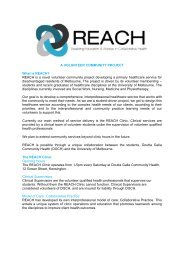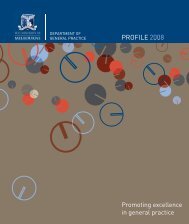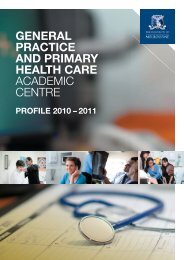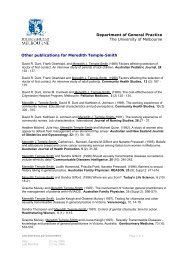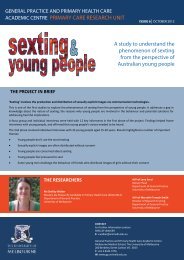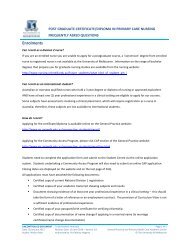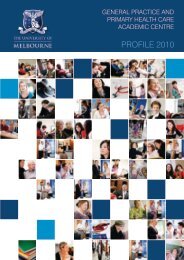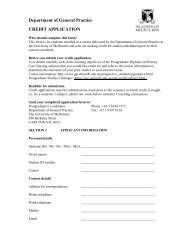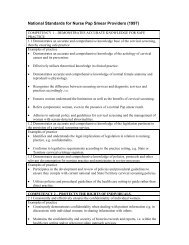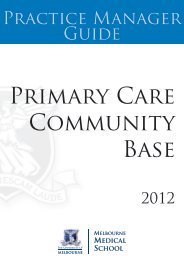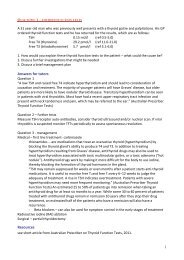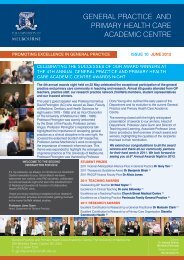here - General Practice and Primary Health Care Academic Centre
here - General Practice and Primary Health Care Academic Centre
here - General Practice and Primary Health Care Academic Centre
- No tags were found...
You also want an ePaper? Increase the reach of your titles
YUMPU automatically turns print PDFs into web optimized ePapers that Google loves.
<strong>Practice</strong>-Based ResearchNetwork Development inVictoria: The VicReN ExperienceMeredith Temple-Smith <strong>and</strong> Melinda Soós
Australia (Victoria)Over 20millionpeople residein AustraliaAlmost 5million residein Victoria
First contact medical care in the community
Challenges in primary care• Equity• Quality• Rural, Outer metro, SES, Indigenous• Difficulty managing workforce <strong>and</strong> funding distribution• Practitioner vocational recognition voluntary• <strong>Practice</strong> accreditation voluntary• Inability to enforce or m<strong>and</strong>ate quality frameworks• Efficiency• Fee-For-Service• Levers to encourage teamwork, integration, quality care• Research culture• Little infrastructure or financial support
The ecology of medical careAdult population atrisk1000Adults reporting oneor more illnesses orinjuries per month750(Ref: White, 1961; Green 2001)Adultsconsulting aGP one ormore times amonth250951Adults admitted tohospital per monthReferredTertiary
Work in<strong>Practice</strong>?Lab basedresearchImportance of communitybased practitioners• Problems vs diseases• Rise of chronic diseaseCan we provide quality carewithout research inpractice?Effective inHumans?
EVIDENCE PRACTICE HEALTH DECISION-MAKINGSince the discovery of the basic tools of molecular biology in the1970s, clinical research output has gradually fallen behind that ofbasic sciences research.Why?Two ‘roadblocks’ between basic science <strong>and</strong> improvedpublic health:1. Between basic science <strong>and</strong> clinical trials2. Between clinical trials <strong>and</strong>…a. <strong>Health</strong> services researchb. Effectiveness / efficacy researchc. Outcomes researchd. Comparative research
Translation roadblocks on way toward improved public healthFundingSource: NIH<strong>and</strong> othersFunding Source:Whose responsibility?BasicScienceResearchTranslationalResearch &Clinical TrialsImplementationresearchImprovedpublichealthTRANSLATION INTO HUMANSTRANSLATION INTOCLINICAL PRACTICESource: Crowley et al 2004
A model…….• Researchusers, translators• Program Focus• Rigorous methods• Quality trainingService<strong>Practice</strong>s<strong>Academic</strong>Units• Researchcollaborators• TeachersResearch<strong>Practice</strong>sResearchLed<strong>Practice</strong>s• Prac-researcherwith PhD/MD
SUMMARY An excellent healthcare system must be underpinned byexcellent clinical research Excellent clinical research can only occur whenresearchers have rigorous skills, time <strong>and</strong> resources International recognition of the crisis in clinical research An exciting opportunity exists for us to facilitate researchin practice
PRIMARY HEALTH CARE: AUSTRALIA<strong>Primary</strong> <strong>Health</strong> <strong>Care</strong> Research, Evaluation <strong>and</strong>Development (PHC RED) Strategy since 2000 Evidence-based policy <strong>and</strong> practice A broad, well-trained active research workforce Attract new researchers into the primary health careresearch workforce Identify knowledge gaps Ensure that evidence is taken up in primary health carepolicy <strong>and</strong> practice
PHC RED STRATEGY4 major Strategy components:• The Australian <strong>Primary</strong> <strong>Health</strong> <strong>Care</strong>Research Institute (APHCRI)• The Research Capacity BuildingInitiative (RCBI)• A program of training awards, <strong>and</strong>investigator-driven <strong>and</strong> prioritydrivenclinical research grants• The <strong>Primary</strong> <strong>Health</strong> <strong>Care</strong> Research<strong>and</strong> Information Strategy (PHCRIS)
PHC RED STRATEGYKey Strategy objectives: To increase the pool of primary health careresearchers To up-skill researchers To support primary health care researchers To ensure the research is relevant to primaryhealth care needs <strong>and</strong> priorities To disseminate <strong>and</strong> facilitate the uptake ofevidence into policy <strong>and</strong> practice
WHAT IS A PRACTICE-BASED RESEARCHNETWORK?‘PBRNs are sustained collaborations between practitioners<strong>and</strong> academicians dedicated to developing relevantresearch questions, working together on study design <strong>and</strong>conduct, <strong>and</strong> translating new knowledge into practice.’Key features: Involve practitioners as well as academics Generate researchPearce et al, 2004 Generate research that is collaborative <strong>and</strong> ‘close topractice’ Are ongoing Object of producing research is to change practice
WHAT IS A PRACTICE-BASED RESEARCHNETWORK?Key features: Involve practitioners as well as academics Generate research Generate research that is collaborative <strong>and</strong>‘close to practice’ Are ongoing Object of producing research is to changepractice
WHAT IS A PRACTICE-BASED RESEARCHNETWORK?Key features: Involve practitioners as well as academics Generate research Generate research that is collaborative <strong>and</strong>‘close to practice’ Are ongoing Object of producing research is to changepractice
WHAT IS A PRACTICE-BASED RESEARCHNETWORK?Key features: Involve practitioners as well as academics Generate research Generate research that is collaborative <strong>and</strong>‘close to practice’ Are ongoing Object of producing research is to changepractice
WHAT IS A PRACTICE-BASED RESEARCHNETWORK?Key features: Involve practitioners as well as academics Generate research Generate research that is collaborative <strong>and</strong>‘close to practice’ Are ongoing Object of producing research is to changepractice
WHAT IS A PRACTICE-BASED RESEARCHNETWORK?Key features: Involve practitioners as well as academics Generate research Generate research that is collaborative <strong>and</strong>‘close to practice’ Are ongoing Object of producing research is to changepractice
WHY ARE PBRN IMPORTANT?For two reasons:a. <strong>Practice</strong>-based research is importantb. PBRN can help bridge the gap betweenevidence, clinical practice, <strong>and</strong> healthdecision-making
WHAT DO PBRN DO?<strong>Academic</strong>sprovide network memberswith opportunities to buildresearch capacityPHC staffprovide networkmembers with accessto a practice baseGenerate research* Contribute to the evidence base* Influence clinical practice* Influence health decision-makingImprove health <strong>and</strong>healthcare delivery
PBRN: RESEARCH PRODUCTIVITY Basic research (research into methods) Clinical research (to inform clinical methods) <strong>Health</strong> services research (improve healthservice industry) <strong>Health</strong> systems research (improve healthsystems <strong>and</strong> policies) Educational research (improve education forPHC clinicians)
CONTRIBUTIONS TO THE EVIDENCE BASE VicReN (Melbourne, Australia) – trialling a new cognitivefunction tool for GPs to use, trials in partner violence <strong>and</strong>child obesity Nijmegen PBRN (the Netherl<strong>and</strong>s) - PHC interventioneffects on CHD, depression, childhood morbidity <strong>and</strong>diabetes Wessex PBRN (UK) - hay fever, osteoporosis, asthma<strong>and</strong> venepuncture Wisconsin PBRN (USA) – disease risk, alcoholism,asthma screening
PBRN HISTORY PBRN origins lie in health surveillance networks <strong>Practice</strong>-based research conducted since late1800s Most experience in the Netherl<strong>and</strong>s, UK <strong>and</strong> US
PBRN HISTORYOpportunity knocks!Opportunity knocks!Opportunity knocks!Opportunity knocks!SEQRNOpportunity knocks!Spencer GulfPRACNETUniversity of NewcastlePHReNet-GPSARNetVicReNOpportunity knocks!
Established May 2007 A collaboration between the<strong>Primary</strong> <strong>Care</strong> Research Unit <strong>and</strong>primary care practices aroundVictoria Open to GPs, PNs,chiropractors, dentists,pharmacists, counsellors,practice managers…
PBRN CONSIDERATIONS Aim FundingGovernance Network leadership Taxonomy of networks Size <strong>and</strong> Staff Communication Monitoring <strong>and</strong> Evaluation Research Training <strong>and</strong> Productivity
Aim:“To spur the development of important <strong>and</strong> highquality primary care research in Victoria that isrelevant to clinical practice <strong>and</strong> through this toprimary care policy-making.”
FUNDINGVicReN is an initiative inknowledge exchange funded by: a University of Melbournespecial purposes grant – Facultyof Medicines, Dentistry <strong>and</strong><strong>Health</strong> Sciences the Research CapacityBuilding Initiative of the <strong>Primary</strong><strong>Health</strong> <strong>Care</strong> ResearchEvaluation <strong>and</strong> DevelopmentStrategy, the Department of<strong>Health</strong> <strong>and</strong> Ageing
VicReN: GOVERNANCEReference GroupHigh-level network guidance<strong>Practice</strong> CommitteeResearch capacity building <strong>and</strong>membershipResearchersLead practices/practitioners(Foundation Members)&A larger group of primary health carepractices/practitionersSubscriber MembersMembers who receive information onlyReference Group<strong>Practice</strong> CommitteeFMResearchersSubscriber Members
VicReN: LINKING MEMBERS Providing monthly e-bulletins Quarterly newsletters VicReN Coordinator organizes the network <strong>and</strong>facilitates all contacts <strong>Practice</strong> Committee meetings Links members into the wider research community
VicReN: MONITORING & EVALUATIONBaseline data is essential Survey members: research capacity<strong>and</strong> practice content <strong>Academic</strong> measures: income,publications, higher degreequalifications, clinical guidelines <strong>and</strong>practice Number of members: member activitylevels, non-project funding, levels ofawareness of the network <strong>and</strong> itsactivities
VicReN: MONITORING & EVALUATIONHow will VicReN’s achievements be measured?Regular monitoring of: research capacity <strong>and</strong> practice content its membership network activitiesSpecific evaluation time-points of: research training <strong>and</strong> research conduct member issues – needs analyses funding, publications, higher degree qualifications, policy
VicReN: BUILDING RESEARCH CAPACITY Aims to provide research skillstraining for members Developing research skillsmaterials Involves members in researchstudies Involves members in wideruniversity research events <strong>and</strong>programs Links members into researchhigher degree opportunities
VicReN: BUILDING RESEARCH CAPACITY<strong>Primary</strong> <strong>Health</strong> <strong>Care</strong> Research <strong>and</strong> Evaluation Strategy(PHC RED) Fellowships Each year the Department of <strong>General</strong> <strong>Practice</strong> hosts practitionerswho research a topicThe Department of <strong>General</strong> <strong>Practice</strong> offers the followingacademic courses: Postgraduate Certificate of <strong>Primary</strong> <strong>Care</strong> Nursing Postgraduate Diploma of <strong>Primary</strong> <strong>Care</strong> Nursing Masters by research PhD MD
VicReN-SUPPORTED STUDIES The detection <strong>and</strong> management ofdementia Shared-care RCT to address childobesity (HopSCOTCH) Telephone-assisted smoking cessationintervention (QUIT) Exercise <strong>and</strong> Type 2 diabetes study RCT to examine abuse <strong>and</strong> violence ofwomen (WEAVE) Acupuncture to treat knee pain study
THE VicReN MODEL <strong>Academic</strong> GP – researchproject development <strong>General</strong> practitioner adviser<strong>and</strong> practice nurse adviser – toprovide the general practiceperspective Forums between VicReNmembers <strong>and</strong> research projectteam members VicReN coordinator – providesconsultative services
THE VicReN MODEL – EXAMPLE HopSCOTCH Shared-care RCT to address childobesity (HopSCOTCH) Developed by a team of researchersat Royal Children’s Hospital (tertiarycare) Intervention to be delivered in partthrough general practice (primary care)
THE VicReN MODEL – EXAMPLE HopSCOTCH Professor Jane Gunn (academicgeneral practitioner) as a chiefinvestigator on the study Dr Cathy Hutton (generalpractitioner) as a GP adviser 2 Forums set up between the projectresearch staff <strong>and</strong> VicReN GPs Consultation services around GPrecruitment provided by the VicReNCoordinator
THE VicReN MODEL – EXAMPLE HopSCOTCH Forums Open invitation to all VicReN GPs toparticipate – the first 5 were selected Paid forum with dinner provided GPs met with the RCH project teamto discuss the current management ofobese children in general practice Helped design the intervention
VicReN: THE FUTURE A larger inclusive primary care network Regular research skills training Member input into research projectdevelopment Ability for members to approach VicReNwith research ideas: project consultancy Continuing access to university forums,seminars, <strong>and</strong> higher degree, fellow <strong>and</strong>funding opportunities More numerous <strong>and</strong> improved links withstakeholders
PBRN: THE FUTURE International Federation of <strong>Primary</strong> <strong>Care</strong> ResearchNetworks (IFPCRN) World Organization of Family Doctors (Wonca) > 50 countries worldwide have PBRN Australia’s PBRN are growing Australian <strong>Health</strong> Minister Tony Abbott hasrecently called for a proposal on PBRN WHO recognize primary care research is essentialto close the 10/90 gap
COMMENTS? QUESTIONSMelinda SoósVicReN CoordinatorDepartment of <strong>General</strong><strong>Practice</strong>The University of Melbourne200 Berkeley Street, Carlton3053 Victoria(03) 8344 3392msoos@unimelb.edu.auwww.gp.unimelb.edu.au/vicren/
REFERENCESJournal ArticlesCrowley, W. et al. (2004). “Clinical Research in the United States at a Crossroads”. JAMA 291(9):1120-1126Lindbloom, E. et al. (2004). "<strong>Practice</strong>-Based Research Networks: The Laboratories of <strong>Primary</strong> <strong>Care</strong>Research." Medical <strong>Care</strong> 42(4 (supplement)): III-45 - III-48Nutting, P. A. (1996). "<strong>Practice</strong>-based research networks: building the infrastructure of primary careresearch." J Fam Pract 42(2)Pearce, K. et al. (2004). "How <strong>and</strong> Why to Study the <strong>Practice</strong> Content of a <strong>Practice</strong>-Based ResearchNetwork." Ann Fam Med 2(5): 425-428Thomas, P. et al. (2006). "How primary care networks can help integrate academic <strong>and</strong> serviceinitiatives in primary care." Ann Fam Med 4(3)White, K. et al (1961). “The ecology of medical care.” N Engl J Med 265: 885-889Zwar, N. et al. (2006). "Supporting research in primary care: are practice-based research networks themissing link?" MJA 185(2): 110-113BooksCouchman W.& Dawson J. (1990) “Nursing <strong>and</strong> <strong>Health</strong>care Research.” Scutari Press, LondonHockey L. (1992) “Surviving the research process.” Deakin University



